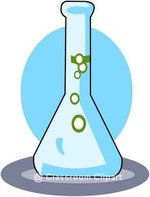Astatine
|
|
Astatine is a chemical element in the periodic table that has the symbol At and atomic number 85. This radioactive element occurs naturally from uranium and thorium decay and is the heaviest of the halogens.
| Contents |
Notable characteristics
This highly radioactive element has been confirmed by mass spectrometers to behave chemically much like other halogens, especially iodine (it probably accumulates in the thyroid gland like iodine). Astatine is thought to be more metallic than iodine. Researchers at the Brookhaven National Laboratory have performed experiments that have identified and measured elementary reactions that involve astatine.
With the possible exception of francium, astatine is the rarest naturally occurring element with the total amount in Earth's crust estimated to be less than 1 oz (28 g) at any one time; this amounts to less than one teaspoon of the element.
History
Astatine (Greek astatos meaning "unstable") was first synthesized in 1940 by Dale R. Corson, K. R. MacKenzie, and [[Emilio Segr蝝 of the University of California, Berkeley by barraging bismuth with alpha particles. An earlier name for the element was alabamine (Ab).
Occurrence
Astatine is produced by bombarding bismuth with energetic alpha particles to obtain relatively long-lived At-209 - At-211, which can then be distilled from the target by heating in the presence of air.
Isotopes
Astatine has 41 known isotopes, all of which are radioactive; the longest-lived isotope is 210At which has a half-life of 8.1 hours. The shortest-lived isotope is 213At which has a half-life of 125 nanoseconds.
References
- Los Alamos National Laboratory - Astatine (http://periodic.lanl.gov/elements/85.html)
External links
- WebElements.com - Astatine (http://www.webelements.com/webelements/elements/text/At/index.html)
- EnvironmentalChemistry.com - Astatine (http://environmentalchemistry.com/yogi/periodic/At.html)

